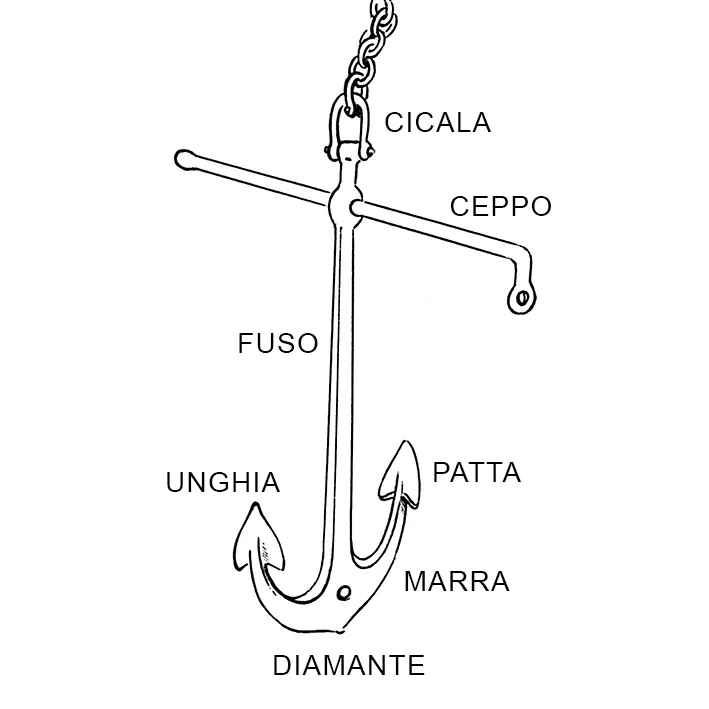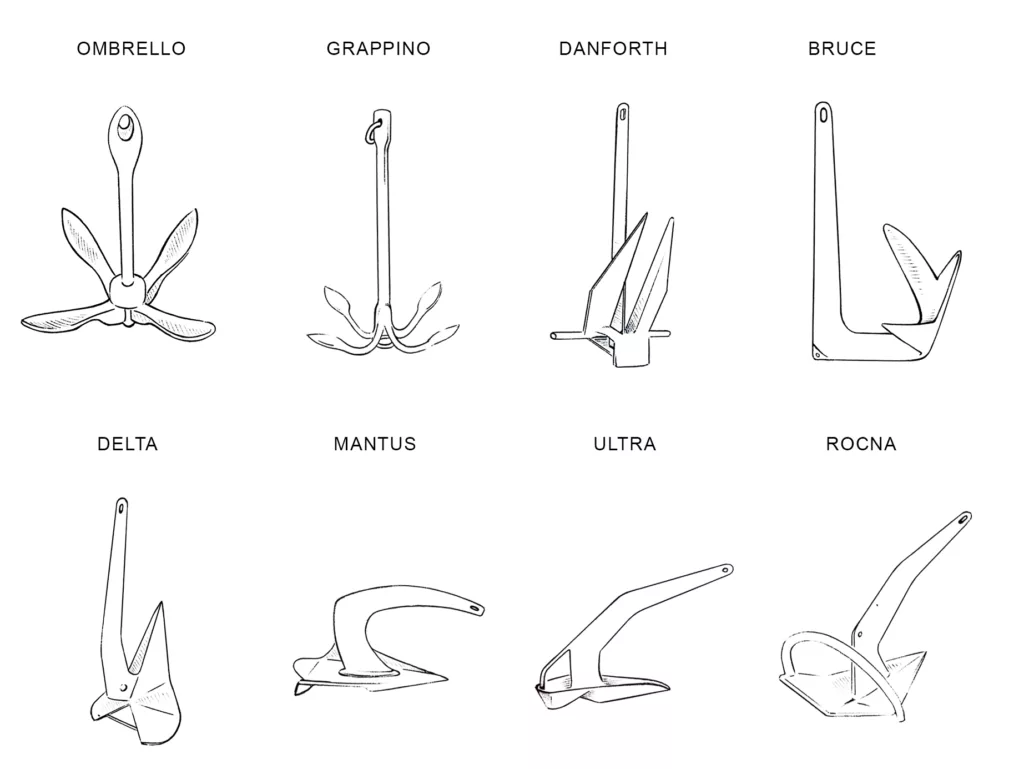The anchoring rules are pretty much the same all over the world… But let’s take a closer look to the specific words of anchoring in Italian – they will be useful if you plan a cruise in Italy!
Anchor parts – in Italian
First of all, the anchor must have a balanced weight relative to the length of the hull.
An anchor weighs on average 1 1/2 to 2 pounds per meter.
Anchor windlasses are usually operated by electric motors, which can be controlled through a wire or radio control.
Attached to the anchor windlass is the barbotin, a toothed wheel on which the chain rotates, remaining firmly in place.
Then there is the anchor nose, mounted at the end of the bow, through which the chain passes before diving into the sea.
The calumus, that is, the chain attached to the anchor, must also be proportionate to the size of the boat, since the result of anchoring largely depends on its length.
Now, let’s look at the parts that make up an anchor, in Italian language:

What parts an anchor is composed of:
- The ceppo slides transversely through a hole drilled in the top of the fuso;
- The fuso is the “neck” of the anchor;
- The diamante is where the fuso joins the marra(s);
- The marra can be fixed or movable, as well as single or multiple. They are the arms of the anchor critical to the anchor itself;
- Patta: the final part of the marra, which allows the anchor to stop on the seafloor.
Anchor types – in Italian

As shown in the figure, there are different types of anchors. In general, ombrello and grappino ones can be said to be suitable on units that tend to be small.
The bruce, on the other hand, has multiple flaps connected to the one fluke, allowing for good anchoring and maneuverability, as does the danforth.
The CQR/delta, on the other hand, is widely used on sailing units. The mantus is excellent: it can independently regain a new hold on the bottom even when the boat suffers wind shocks and the anchor temporarily becomes unanchored.
Also popular are the ultra and rocna, used mainly because they can anchor to the seabed quickly and without risk of capsizing.
Before dropping the anchor, it is first of all essential to understand the type of bottom you are going to.
Type of seabed
Seabeds are divided into:
- Bad keeper: here the slime in the seabed prevents the anchor from securing properly. The risk of slipping is high. A rocky seabed is also bad, because the anchor slides without holding or (worse) getting stuck;
- Good tenor: sand and seaweed are good, except for Posidonia, which also is classified as seaweed;
- Very good tenor: mud is a very good tenor, since it allows the anchor to grip the bottom without plowing or shipping (as it does on slime).
General rules for anchoring
- Generally, in calm water, the calamus should be cast for a length of 3 times the depth of the bottom;
- Before dropping anchor, you should check on charts and pilot books how the seabed will be. Also, check the local rules and prohibitions;
- The bow should be anchored upwind so as to avoid excessive displacement of the boat;
- Avoid ramming and overlapping with other chains. This can be done by waiting until the boat is stationary to row the anchor, always checking the distance from the coast and other boats;
- If the seafloor is rocky, operate the depth sounder, or a manual sounder;
- If the bottom is not optimal, use the grippiale (a line attached to the diamante that, if pulled when the anchor is on the seabed, makes it easier to retrieve it).
In all this, you should remember common sense: report your location as appropriate (whether night or day signaling) and keep an eye on weather conditions.
Types of anchorage
1) Wheel anchorage: this is done in the roadstead with a single anchor. This anchorage allows the boat to make a 360-degrees turn. Watch out and leave enough space for other units and objects in the sea;
2) Anchor penned: ideal in rough seas and critical weather conditions. A second anchor called a “brush” is attached to the diamond of the main anchor;
3) Two calumas are spun separately, observing an angle of 45° to 60° between them. This method is even safer in uncertain weather conditions.
Verify anchorage
To verify anchorage, the anchor must first be spun, then take as reference two points along the coast, one straight ahead (in the direction the anchor is facing), one to port, toward the coast.
Wait about ten minutes at this point, and when the bow is swinging back toward the first point, check that from port side you are still aligned with the second point.
If you have lost alignment and the point is advancing toward the bow, it means the anchor is plowing and it is time to re-anchor.

Pingback: The signals of river navigation in Italy - Yacht surveys for sailing and motor boats